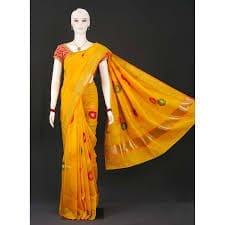Exquisite sarees showcasing 17 eclectic weaves from India garnered the spotlight at the London Fashion Week. As the golden-hued mekhela chador, the precious kasavu, exquisite kanjivaram, intricate paithani, delicate baluchuri and garad, and other varieties like the kantha, sambalpuri, chanderi, bhadhni, ghatchola, phulkari sashayed down the ramp, it was a tribute to the craftspeople and weavers who create these masterpieces.
All the sarees belonged to the High Commission staff members and few belonged to High Commissioner, Ruchi Ghanshyam. The High Commission of India, London in collaboration with INIFD and London School of Trends organised the Saree Fashion Show at London Fashion Week, Victoria House. Prior to the ramp walk, Union minister of textiles Smriti Irani shared a video message about the splendid display and rich heritage of sarees.
Applauding the initiatives, Ramya Rao, co-founder, Kalaneca, said, “It’s really a unique initiative, 17 kinds of unique weaves from women’s wardrobe made it to the ramp. Initiatives like these are ensuring every handwoven weave from the Indian diaspora gets recognised thereby showcasing the diversity of colours, threads, weaving and wearing styles. I think exposure to handwoven weaves must start early. Since the focus is on sustainable fashion, a lot of emphasis should go on why wearing handwoven clothes is important. Finally, everyone should choose a handwoven saree to have their first saree experience. That sets the foundation for them to choose a handloom instead of a powerloom saree.”
Appreciating the initiative and sharing their views with Fibre2Fashion, Puneet Jain and Yatin Jain, directors of Odhni, said “The fashion fraternity has kept the Indian culture alive by showcasing sarees at such great platforms. From celebrities wearing the saree at global events to designers organising their shows at the global level showcasing sarees, such initiatives have placed the saree on the world map.”
Talking about initiatives taken to promote Indian handloom sarees, they said, “Fashion shows play a key role in showcasing or promoting any apparel, including Indian attires like saree. Changing the perceptions of consumers regarding handloom products should be the primary target. Enlightening them with the fresh aspect of it will change their mindset and will make handloom more acceptable. Further, the availability of handloom products on e-commerce sites or online stores would increase awareness and usage of handloom products manifolds.”
Speaking about the importance of sarees, Raghuram Kuchibhatla, founder, YesPoho, said, “Sarees are not like other outfits. Thousands of years of Indian tradition is woven into sarees. That is why, it is hard for us to think about sarees in terms of brands. Saree gives a woman a sense of luxury, grace, elegance and femininity like no other. Saree makes the woman wearing it feel like a princess, glamorous, beautiful and special. It is often mentioned that sarees are unique and that no two sarees are the same, essentially this is because sarees come in a whole range of different fabrics, colours, patterns, with different prints, work…there is literally no end with the kind of variety one can have in the wardrobe with just a few sarees. Saree, after having survived hundreds of years of changes, invasions, and colonisation has emerged as a much more fancied, glamorous and a sexy outfit, adorned by women all over the world. This is because of its in-born characteristics of versatility, appeal and fit for every occasion.”
So, more events on the wonderful saree culture should be promoted on international platforms, to create the interest of the fashion lovers towards this rich heritage ethos of India.

